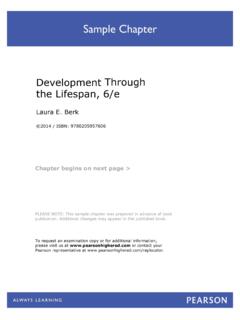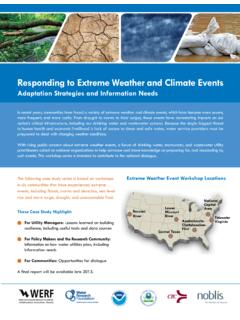Transcription of Meats, Poultry, and Fish - Pearson
1 253 OBJECTIVESA fter studying this chapter, you will be able to:1. Describe the structure and composition of muscle, connective tissue, and Identify the pigments in meat and the changes that occur during heating and Discuss the factors determining meat Identify meat cuts, grades, and the marketing Explain the methods of meat cookery and the rationale for using Identify various modified meat Explain the composition of gelatin and its foods usually are categorized as meat, poultry, or fish. Meat includes all red meats from animal sources, although the only ones commonly available are beef, veal, pork, and lamb (or mutton in some countries).
2 Poultry is the inclusive term for turkey, chicken, and duck, as well as pheasants and other less available fowl. Fish, in the broad sense, designates aquatic animals, but frequently it is the more narrow classifi-cation that includes only fish with fins, gills, a backbone, and a skull. Shellfish, the other classification of aquatic animals, is subdivided into mollusks and crustaceans, the former having a shell and the latter a horny meats, including beef, veal, pork, and and the EnvironmentThe public has heard the message of the health benefits of omega-3 fatty acids, which are found in abundance in seafood.
3 Increased consumption of these fish has created concern about overfishing of various popular fish, and limits have been placed on the take for both commercial and sport fishermen . Nature also plays a significant role in determining when and where seafood will thrive. Water FOOD FOR THOUGHT(Continued)Meats, Poultry, and Fish12 CHAPTER OUTLINEO bjectivesClassificationFood For Thought: Fish and the EnvironmentStructureMuscle Tissue Connective Tissue FatPigmentsMyoglobin and Related Compounds Changes Effected by Heating Changes Effected by CuringMeat QualityFactors Affecting Quality Inspection and GradingIdentifying Meat CutsMarketingFresh/FrozenFood for Thought: Kosher/HalalDomestic/ForeignIngredient Insights: Apples and an Antimicrobial Edible FilmCarcass/Case-ReadyFood for Thought.
4 Shrimp AhoyPreparationChanges Effected by Heat Effects of Altering pH Effect of Salt Meat TenderizersModified Meat ProductsReduced-Fat Meats Restructured MeatsComminuted Meats Structured Seafood ProductsSoy ProteinProducts Using Textured Soy Protein Quorn Food for Thought: Petri Burgers?GelatinComposition PropertiesSummaryStudy 25312/10/15 1:47 PM254 Part 4 ProteinsShellfishSubclassification of fish; includes mollusks and with a protective , lobsters, crabs, and other shellfish with a horny in the oceans have been changing.
5 Measurements taken by the National Oceanic and Atmospheric Administration (NOAA) along the Pacific Coast indicate that water temperature recently has been rising faster than it did at the beginning and during much of the past are reporting changes in the types and numbers of seafood in their locales. Humboldt squid and marlin, normally found in waters off Baja California, are now being caught as far north as Washington; the squid population found near San Francisco is increasing rapidly. San Diego fishermen are reporting reduced numbers of albacore, but more yellowfin tuna (the kind valued for making sushi).
6 fishermen off the coast of Oregon and Washington have been dealing with significant limits on the salmon they can take home; the good news is that more albacore tuna are found in this region as warmer waters have promoted their movement the East, some people blame the warming water in Chesapeake Bay for causing an illness (mycobacteriosis) in bass living there. Algae are flourishing and taking some oxygen from the water, which may be a factor in the health of the bass population. Reduced oxygen content in the water is a potential problem in coastal waters and can cause a drop in the number of fish on both coasts in the on the extent of glacial melt and the long-term effects on sea level suggest that present marshlands along the coast may disappear as the water gets deeper, and the area is transformed into open sea.
7 When this happens, the population of crabs, shrimp, and menhaden, as well as some other types of sea life that reproduce in the sheltered marshy setting, will be reduced. These are some of the problems that need to be monitored and alleviated as much as possible to avoid losing valuable variety and quantities of seafood to feed the a different environmental problem is developing for fish in the Great Lakes. The current situation has evolved from importing of some Asian carp by a fish farmer in Arkansas in 1972. The imported carp were effective in keeping holding pens clean and caused no concern until flooding in the 1990s released them into local streams.
8 Unlike the common carp, which were already there and weighed around 25 pounds, the Asian carp ate voraciously and displaced most of the native fish as they worked their way north in streams and rivers. These giant fish may weigh as much as 100 pounds, and they are so strong that they can injure people in small boats when they soar as high as 8 feet out of the water. Not only are these giant carp badly behaved, they don t even taste good and are full of bones, all of which removes them from the risk of appearing on dining tables. In other words, they are a menace to the edible fish supply (Figure ) and to hapless boaters.
9 Now giant carp have arrived in Chicago, where vigorous and costly efforts are being made to keep them from escaping into Lake Michigan. This effort amounts to environmentalists last chance to protect all of the Great Lakes from giant Asian carp. Failure to stop them will have a devastating impact on the fishing industry and sport fishing in all of these defined as aquatic animals, but more narrowly defined to designate those with fins, gills, a backbone, and a Both recreational and commercial fishing are threatened in Lake Michigan by non- native giant , notably turkey, chicken, and 25412/10/15 1:47 PMChapter 12 Meats, Poultry, and Fish 255 STRUCTUREM uscle TissueComponents Water is the primary constituent in muscle; actually, it is about 75 percent water.
10 The next most abundant substance, protein, is a distant second, constituting only about 18 percent of the total. The amount of fat is highly variable, but commonly ranges from 4 to 10 percent. Carbohydrate, primarily in the form of glycogen plus a small amount of glucose and glucose 6-phosphate, accounts for a little more than 1 percent of the total. Vitamins, minerals, and trace amounts of various organic compounds complete the specific composition of muscle tissue varies from muscle to muscle and even from one spot to another within a muscle. This variation makes the testing of meats a challenging task.












